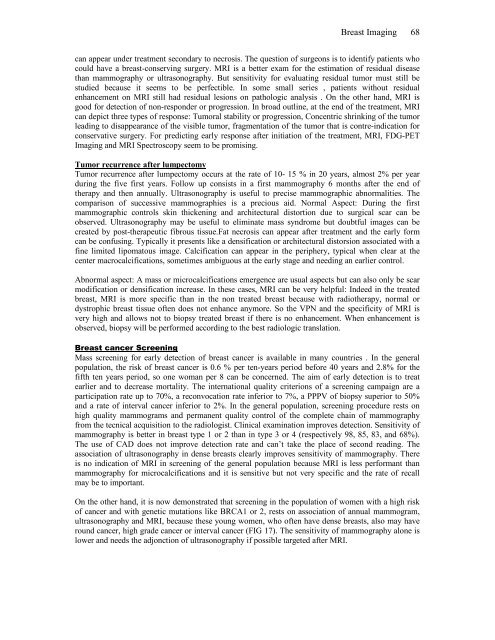Breast Cancer - Arab Medical Association Against Cancer
Breast Cancer - Arab Medical Association Against Cancer
Breast Cancer - Arab Medical Association Against Cancer
- No tags were found...
You also want an ePaper? Increase the reach of your titles
YUMPU automatically turns print PDFs into web optimized ePapers that Google loves.
<strong>Breast</strong> Imaging 68can appear under treatment secondary to necrosis. The question of surgeons is to identify patients whocould have a breast-conserving surgery. MRI is a better exam for the estimation of residual diseasethan mammography or ultrasonography. But sensitivity for evaluating residual tumor must still bestudied because it seems to be perfectible. In some small series , patients without residualenhancement on MRI still had residual lesions on pathologic analysis . On the other hand, MRI isgood for detection of non-responder or progression. In broad outline, at the end of the treatment, MRIcan depict three types of response: Tumoral stability or progression, Concentric shrinking of the tumorleading to disappearance of the visible tumor, fragmentation of the tumor that is contre-indication forconservative surgery. For predicting early response after initiation of the treatment, MRI, FDG-PETImaging and MRI Spectroscopy seem to be promising.Tumor recurrence after lumpectomyTumor recurrence after lumpectomy occurs at the rate of 10- 15 % in 20 years, almost 2% per yearduring the five first years. Follow up consists in a first mammography 6 months after the end oftherapy and then annually. Ultrasonography is useful to precise mammographic abnormalities. Thecomparison of successive mammographies is a precious aid. Normal Aspect: During the firstmammographic controls skin thickening and architectural distortion due to surgical scar can beobserved. Ultrasonography may be useful to eliminate mass syndrome but doubtful images can becreated by post-therapeutic fibrous tissue.Fat necrosis can appear after treatment and the early formcan be confusing. Typically it presents like a densification or architectural distorsion associated with afine limited lipomatous image. Calcification can appear in the periphery, typical when clear at thecenter macrocalcifications, sometimes ambiguous at the early stage and needing an earlier control.Abnormal aspect: A mass or microcalcifications emergence are usual aspects but can also only be scarmodification or densification increase. In these cases, MRI can be very helpful: Indeed in the treatedbreast, MRI is more specific than in the non treated breast because with radiotherapy, normal ordystrophic breast tissue often does not enhance anymore. So the VPN and the specificity of MRI isvery high and allows not to biopsy treated breast if there is no enhancement. When enhancement isobserved, biopsy will be performed according to the best radiologic translation.<strong>Breast</strong> cancer ScreeningMass screening for early detection of breast cancer is available in many countries . In the generalpopulation, the risk of breast cancer is 0.6 % per ten-years period before 40 years and 2.8% for thefifth ten years period, so one woman per 8 can be concerned. The aim of early detection is to treatearlier and to decrease mortality. The international quality criterions of a screening campaign are aparticipation rate up to 70%, a reconvocation rate inferior to 7%, a PPPV of biopsy superior to 50%and a rate of interval cancer inferior to 2%. In the general population, screening procedure rests onhigh quality mammograms and permanent quality control of the complete chain of mammographyfrom the tecnical acquisition to the radiologist. Clinical examination improves detection. Sensitivity ofmammography is better in breast type 1 or 2 than in type 3 or 4 (respectively 98, 85, 83, and 68%).The use of CAD does not improve detection rate and can’t take the place of second reading. Theassociation of ultrasonography in dense breasts clearly improves sensitivity of mammography. Thereis no indication of MRI in screening of the general population because MRI is less performant thanmammography for microcalcifications and it is sensitive but not very specific and the rate of recallmay be to important.On the other hand, it is now demonstrated that screening in the population of women with a high riskof cancer and with genetic mutations like BRCA1 or 2, rests on association of annual mammogram,ultrasonography and MRI, because these young women, who often have dense breasts, also may haveround cancer, high grade cancer or interval cancer (FIG 17). The sensitivity of mammography alone islower and needs the adjonction of ultrasonography if possible targeted after MRI.









